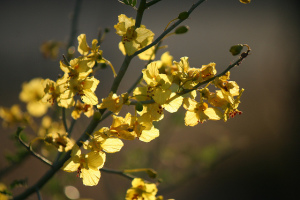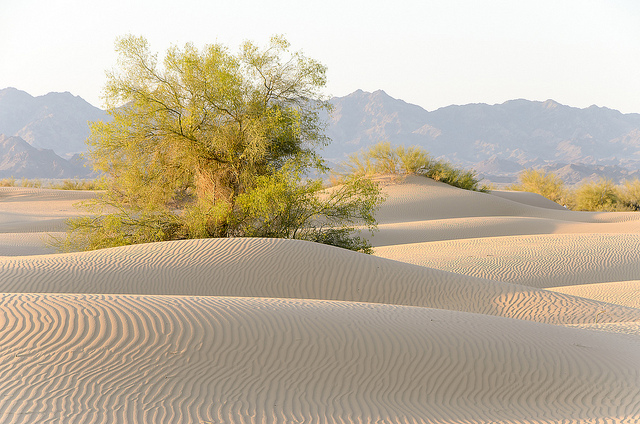Ecological restoration is inspirational in the sense that you connect with the earth in a new or different way. I find that I reflect on the history—or what I believe to be the history—of the place I am working. My mind wanders to how this place has gone through changes. Did a stream flow through here, were populations of deer, elk, or bison ever present? Did Native Americans alter the site, use it for supplies, harvest food?
Here I am manipulating the site to permit the land to heal. How far should one go in pursuit of the healing process? Where does one stop and why? Are we so arrogant to think we know the path—is there only one path? No, of course not, there are many.
On a hike in a dried desert streambed, I noticed how the plants were distributed. Coming around a bend, I came upon a small grove of young palo verde trees. What permits them to exist? How did they come to be here? With the numerous seed eating animals living here, how is it that all those seeds escaped being eaten by voracious seed eaters—insects, mammals, and birds? Were the seeds immediately buried once falling to the ground? Were there no animals at the time so that they could linger on the surface before being buried?
This grove is not close to any seed-producing palo verde trees, so the seeds that became these trees must have been carried down the stream when it still held water. Being washed downstream scratched the seed coats, which permitted germination. As the seeds settled out of the stream and were covered by sand and silt, the soil column was charged with water, allowing the seeds to grow.
 How many of these flowers will produce seeds that will survive to germinate and create trees? Photo by Lars Hammar, used under Creative Commons licensing.
We know that not all seeds are viable, not all seedlings make it beyond the two-leaf stage, and so forth. But nonetheless here is this grove of over 200 palo verde trees about two feet high. I wonder how deep their roots stretch as they pursue the receding groundwater that seeks to join the aquifer or is absorbed by well-established plants along the streambed. How far must those roots go and how many will make it?
I often think about that visit, although it was my first and last time there and more than thirty years ago. It was a remote area of the desert, I have not been able to return, I am not even sure I could find the site again. Yet the short time I spent there has remained with me as I ponder how I can insert myself into the restoration process and account for the many factors that can affect a restoration project. I think about the various events that had to come together for that grove to begin. In essence it has become a template from which I think about projects that I am about to embark upon. And while my involvement on a project lasts only a defined amount of time, my goal is always to create another grove that is properly prepared to handle the environmental elements it faces.
How many of these flowers will produce seeds that will survive to germinate and create trees? Photo by Lars Hammar, used under Creative Commons licensing.
We know that not all seeds are viable, not all seedlings make it beyond the two-leaf stage, and so forth. But nonetheless here is this grove of over 200 palo verde trees about two feet high. I wonder how deep their roots stretch as they pursue the receding groundwater that seeks to join the aquifer or is absorbed by well-established plants along the streambed. How far must those roots go and how many will make it?
I often think about that visit, although it was my first and last time there and more than thirty years ago. It was a remote area of the desert, I have not been able to return, I am not even sure I could find the site again. Yet the short time I spent there has remained with me as I ponder how I can insert myself into the restoration process and account for the many factors that can affect a restoration project. I think about the various events that had to come together for that grove to begin. In essence it has become a template from which I think about projects that I am about to embark upon. And while my involvement on a project lasts only a defined amount of time, my goal is always to create another grove that is properly prepared to handle the environmental elements it faces.
 How many of these flowers will produce seeds that will survive to germinate and create trees? Photo by Lars Hammar, used under Creative Commons licensing.
How many of these flowers will produce seeds that will survive to germinate and create trees? Photo by Lars Hammar, used under Creative Commons licensing.


